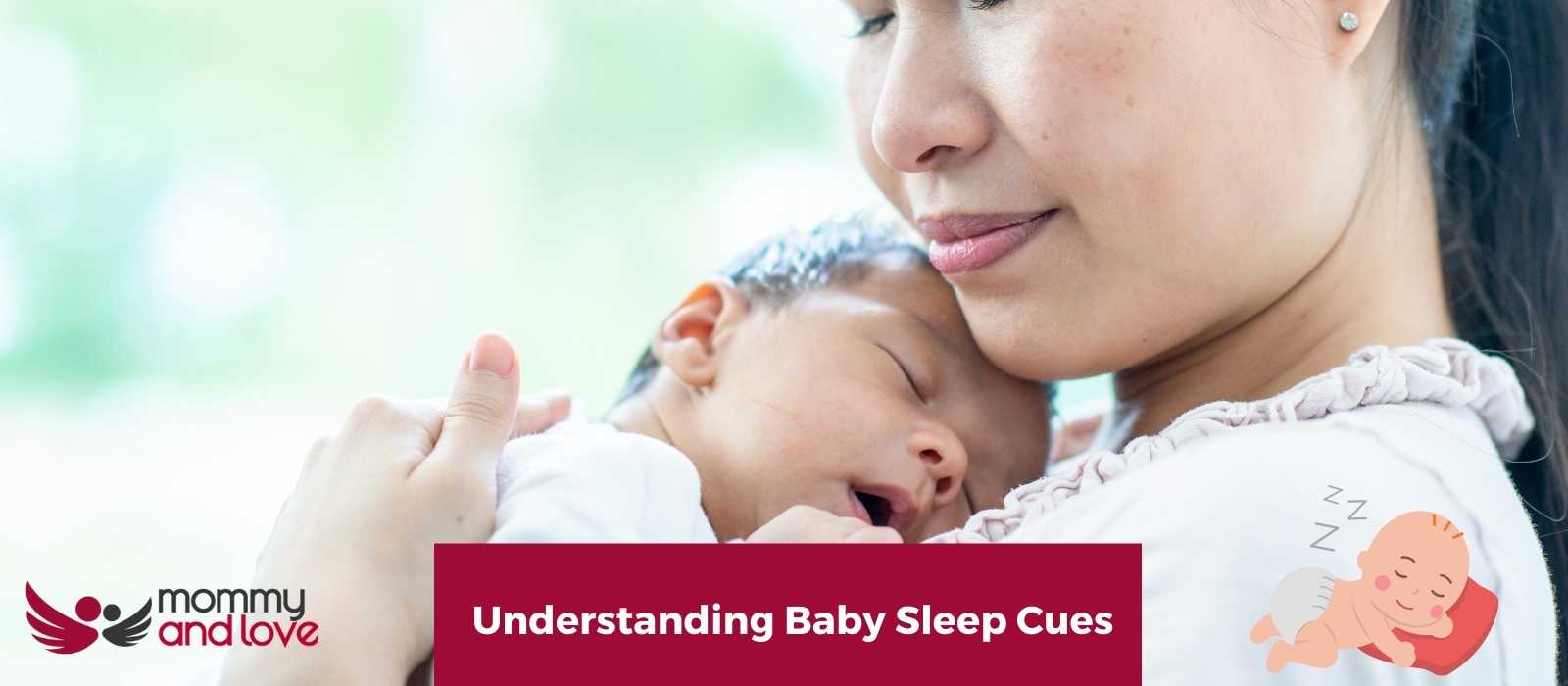Do you ever feel like you’re walking on eggshells around your baby? That’s because you probably are! Babies are experts at communicating their needs, and one of the most important ways they do this is through baby sleep cues.
Your baby will have his own unique signs that it’s time to sleep, but here are some that most babies have that can help you start to look for your baby’s signs: yawning. jerky movements. becoming quieter and less interested in playing.
Let’s discuss common sleep cues first.
What Are Common Baby Sleep Cues?

As a new parent, you might be wondering what sleepy cues are and how to identify them in your baby.
Keep in mind that a sleep cue often depends on the baby’s age.
It’s important for parents to be able to recognize and identify a baby’s individual behavior pattern in terms of sleeping habits which include infant sleep time or how long baby sleeps at night and awake time.
Sleep cues are signals that indicate to your baby that it is time to sleep. It is a great starting point for achieving great naps. Identifying these cues from young babies can help you create a bedtime routine that will cue your baby to start winding down for the night.
Note that every baby is unique and may show many potential sleep cues. Older babies might show different baby’s cues for sleep or nap time than younger ones. After all, babies are still in what many people call the “super sleepy newborn stage”
You should be observant and watch out for the best sleep cue of your baby that indicates he’s ready for his next nap.
Additionally, paying attention to the differences between hunger cues which are for feeding time and sleep cues for best naps and sleeps can save you a lot of trouble.
Common Sleep Cues
Common sleep cues in babies include yawning, rubbing their eyes, and being a bit fussy. If you notice your baby’s cue, it is a good idea to prepare him to get into bed. This might involve giving your baby a bath, reading a book together, or singing a lullaby.
The above cues are just a few examples of what a baby does when she wants to sleep. You should also know about common optimal waketime lengths and wake windows so that you can prepare a routine or make necessary adjustments to your baby’s bedtime habits to make her sleep longer based on cues displayed.
Creating a consistent sleep routine will help your baby learn to sleep through the night, read out guide to what to do if your baby is waking every hour. If you are having trouble identifying possible sleep cues or creating a routine, talk to your child’s doctor or a sleep specialist. They can help you create a plan that will work for your family.
How to Identify Your Baby’s Sleep Cues

One of the most important things you can do to help your baby sleep through the night is to learn to identify their sleepy cues.
But what exactly are sleepy cues? Sleepy cues are any kind of sign or signal that your baby is tired and ready for a nap or sleep.
When the average person thinks of signs of a sleepy baby, they think of yawning, droopy eyes, and fussiness. Well, they’re not wrong.
Types of Sleep Cues
There are two main types of sleepy cues: overt and covert.
Overt baby sleep cues are explicit and easy to spot. They might include things like yawning, rubbing their eyes, or getting fussy.
Covert sleep cues, on the other hand, are more subtle and can be harder to identify. They might include changes in breathing patterns or body temperature.
The best way to learn your baby’s sleep cues is to pay close attention to them during the day. See if he’ll yawn or if your baby displays other discernible cues that he wants a good nap.
It’s handy to keep a journal of when you see the cues and what was happening at the time. For instance, some babies are ready to go to bed at the first yawn, while others at the third yawn. Some people erroneously wait for that “too late cue” even if they already saw a legitimate cue.
If you can learn to identify what is normal and judge baby’s sleep cues, you’ll be one step closer to helping them get the sleep they need when they’re ready for a nap.
How Do You Respond to Baby’s Sleep Cues?
There are a few different ways to respond to the baby’s sleepy cues and tired signs.
- One way is to let the baby cry it out. This method is often used by parents who want their babies to learn how to self-soothe and let babies sleep on their own when they’re ready for a nap.
- Another way to respond to the baby’s sleep cues is through what is called “The Ferber Method.” This is a method where the parent allows the baby to cry for set periods of time before going in to soothe them. This method is often used by parents who want their baby to learn how to self-soothe, but still want to be involved in the process.
- Another response to definite sleep cues and tired signs is called “The No-Cry Method.” This is a method where the parent tries to soothe the baby without letting them cry. This method is often used by parents who want to be very involved in the process and do not want their baby to cry at all.
- Make a baby’s sleep cue list including tired signs so that you will be familiar with them.
What Happens if a Baby Doesn’t Show Sleep Cues?

If a baby doesn’t show sleep cues, it’s important to look for other signs that they may be ready for sleep. These can include rubbing their tired eyes, yawning, or being fussy.
It’s also important to create a consistent sleep routine that includes some of the baby’s favorite activities. This can help signal to them that it’s time to sleep. Examples of bedtime routines can include a bath, reading a book, or singing a lullaby.
If you’re still having trouble starting nap, there are some other things you can try. These include white noise machines, swaddling, and rocking.
Remember, every baby is different so what works for one may not work for another. The most important thing is to be patient and keep trying until you find something that works for your little one.
When Should You Start Tracking Baby Sleep?
Some parents start tracking sleep as well as the time awake from the moment their baby is born, while others wait until their child is a bit older. There’s also a tight range of time between a baby’s two naps.
There are benefits and drawbacks to both approaches.
Starting to track sleep from the beginning can help parents get a sense of their baby’s natural sleep patterns. This information can be helpful in making decisions about things like bedtime and naps. It can also help parents troubleshoot sleep problems that may arise. For instance,
Make notes of your baby’s sleeping habits as well as the number of hours your baby sleeps every day.
However, tracking sleep can also be a lot of work. Parents who start from the beginning may find themselves feeling anxious or guilty if their baby doesn’t seem to be sleeping well. They may also feel like they are missing out on precious sleep themselves!
Waiting to track sleep can also have its benefits. Parents who wait may find it easier to relax and enjoy their baby’s sleeping patterns, rather than worrying about them. They may also feel like they have a better handle on their own sleep habits before they start tracking their children.
What Does Newborn Active Sleep Look Like?
Newborns spend most of their time in active sleep. This is the sleep stage when they are busiest growing and developing.
During active sleep, your baby’s brain is very active. They are busy forming connections between neurons and building new skills. This is why it is so important for most babies to get enough active sleep.
Active sleep is also when babies are most likely to have night terrors (young babies can’t have nightmares). This is perfectly normal and nothing to worry about. However, it should be noted that one baby might show different signs of active sleep than the next.
Getting enough active sleep is crucial for your baby’s development, so make sure they are getting plenty of opportunities to sleep.
What Is Excessive Yawning of a Baby a Sign Of?

A baby’s excessive yawning may be a sign of fatigue, sleepy state or boredom. It might also mean that your baby needed to be in his crib sooner than later for his next few naps.
If your baby is excessively yawning, try to engage them in more stimulating activities.
Excessive yawning could be a sign of an underlying health condition, so it’s always best to err on the side of caution. If this habit becomes worrisome, you can always talk to your baby’s pediatrician or doctor.
How Do I Get My Baby to Stop Fighting Sleep?
If your baby is fighting sleep to stay awake, there are a few things you can do to help.
First, try to create a calm and relaxing environment for your baby before bedtime. This may include dimming the lights, playing soft music, or giving your baby a gentle massage and having a lovely relaxing bath.
You should also avoid stimulating activities such as watching television or playing active games before bed.
If your baby is still fighting sleep, you can try rocking or nursing them to sleep. However, be sure to put your baby down in their crib when they are asleep so they do not become dependent on these methods. Read our guide to vibrations and newborns.
How Do I Get an Overtired Baby to Fall Asleep Quickly?
If your baby is overtired, it can be hard to get them to bed. Here are a few tips to help:
- White noise can help soothe and calm an overtired baby. There are a variety of white noise machines and apps available.
- Gently rocking or bouncing your baby can help them to fall asleep.
- If your baby is old enough to use a pacifier, it can help them to self-soothe and fall asleep.
If you try these tips and your baby still doesn’t seem to be falling asleep, it’s best to consult with a doctor or sleep specialist. They can help you create a customized plan to help your baby (and you!) get the sleep you need.
Is Yawning a Late Sleepy Cue?
Yes, yawning can be a sign that your baby is sleepy. If you see your baby yawning, it’s a good idea to put them down for a nap. Yawning is often one of the last cues that babies give before they fall asleep. So if you see your baby yawning, it’s time to start getting them ready for bed.
There are a few things you can do to help your baby sleep better. First, make sure your baby sleeps in a dark and quiet room. Second, establish a bedtime routine that includes a bath, storytime, and cuddles. And finally, don’t forget to put them down drowsy but awake so they can learn to fall asleep on their own.
The Take-Away on Understanding Baby’s Sleep Cues
So, how do you tell when your baby is ready for sleep? By looking for common baby sleep cues, and others that are unique to your baby. If you’re still not sure, it’s always safest to put your baby down when he’s calm and sleepy but awake.
That way, if he’s not quite ready to fall asleep, he’ll let you know and you can try again later.

This article was written by: Gian MIller – Full-Time Writer, Baby Whisperer & Dad of 3.
Gian spends a lot of his time writing. A self-proclaimed baby whisperer, Gian has been through it all with his own children and is passionate about sharing his hard-won wisdom with other parents. When he’s not writing or changing diapers, you can find him playing the guitar or watching baseball (or preferably both at the same time).




